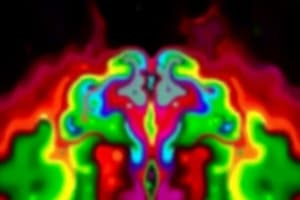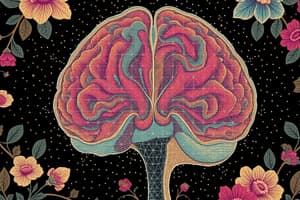Podcast
Questions and Answers
Which brain structure is associated with motor activity, speech, and planning?
Which brain structure is associated with motor activity, speech, and planning?
- Frontal lobe (correct)
- Basal ganglia
- Lateral geniculate nuclei
- Hindbrain
Which brain structure is the visual relay station?
Which brain structure is the visual relay station?
- Ventral posterior nuclei
- Medial geniculate nuclei
- Basal ganglia
- Lateral geniculate nuclei (correct)
Which brain structure is associated with auditory perception, memory, and emotion?
Which brain structure is associated with auditory perception, memory, and emotion?
- Temporal lobe (correct)
- Anterior cingulate cortex
- Dorsolateral prefrontal cortex
- Medial geniculate nuclei
Which brain structure is part of the Triune Brain and associated with survival instincts?
Which brain structure is part of the Triune Brain and associated with survival instincts?
Which brain structure is responsible for conflict monitoring?
Which brain structure is responsible for conflict monitoring?
Which brain structure is associated with attention allocation, intention, and value?
Which brain structure is associated with attention allocation, intention, and value?
Which brain structure is involved in working memory, temporal memory, and source memory?
Which brain structure is involved in working memory, temporal memory, and source memory?
Which brain structure is responsible for integrating sensory information and spatial tasks?
Which brain structure is responsible for integrating sensory information and spatial tasks?
Which technique is mentioned as a newer method that can temporarily inhibit processing in a given area?
Which technique is mentioned as a newer method that can temporarily inhibit processing in a given area?
What is described as involving experiments on healthy individuals under controlled laboratory conditions, with limitations such as lack of ecological validity and indirect measures?
What is described as involving experiments on healthy individuals under controlled laboratory conditions, with limitations such as lack of ecological validity and indirect measures?
What does cognitive neuropsychology assume?
What does cognitive neuropsychology assume?
Which evidence in cognitive neuropsychology involves the presence of selective deficits?
Which evidence in cognitive neuropsychology involves the presence of selective deficits?
What does the text emphasize the importance of in cognitive neuroscience?
What does the text emphasize the importance of in cognitive neuroscience?
Which technique is highlighted as a method used to study brain structure and function relevant to human cognition?
Which technique is highlighted as a method used to study brain structure and function relevant to human cognition?
What is described as involving the study of patterns of cognitive performance exhibited by brain-damaged individuals?
What is described as involving the study of patterns of cognitive performance exhibited by brain-damaged individuals?
What is the importance emphasized in the text regarding the use of neuroimaging techniques?
What is the importance emphasized in the text regarding the use of neuroimaging techniques?
What is mentioned as a limitation of experimental cognitive psychology?
What is mentioned as a limitation of experimental cognitive psychology?
What does cognitive neuropsychology assume about impairments?
What does cognitive neuropsychology assume about impairments?
What is emphasized as important in the evaluation of one's knowledge of brain structures and understanding of research methods?
What is emphasized as important in the evaluation of one's knowledge of brain structures and understanding of research methods?
What is highlighted as the need in cognitive neuroscience?
What is highlighted as the need in cognitive neuroscience?
Flashcards are hidden until you start studying
Study Notes
Cognitive Neuroscience and Neuroimaging Techniques
- The text discusses cognitive neuroscience and neuroimaging techniques used to study brain structure and function relevant to human cognition.
- It highlights the various techniques used in cognitive neuroimaging, such as single-unit recording, event-related potentials (ERPs), positron emission tomography (PET), and magnetic resonance imaging (MRI and fMRI).
- The newer technique of transcranial magnetic stimulation (TMS) is also mentioned, which can temporarily inhibit processing in a given area.
- Experimental cognitive psychology is described as involving experiments on healthy individuals under controlled laboratory conditions, with limitations such as lack of ecological validity and indirect measures.
- The study of patterns of cognitive performance exhibited by brain-damaged individuals in cognitive neuropsychology aims to provide knowledge about normal human cognition and reveals complexities when the system malfunctions.
- Cognitive neuropsychology assumes functional and anatomical modularity, uniformity of functional architecture across individuals, and subtractivity (impairments cannot add to systems).
- The text also discusses the evidence in cognitive neuropsychology, including performance dissociations and double dissociations, and its limitations such as compensation for impairments and diverse patients with similar brain damage.
- It emphasizes the importance of combining techniques in cognitive neuroscience and the need for theoretically driven neuroimaging.
- The text provides a list of required reading, online resources, and video recommendations for further study in cognitive neuroscience and neuroimaging techniques.
- It encourages the evaluation of one's knowledge of brain structures, understanding of research methods, and appreciation of the interplay of regions in complex tasks.
- The text highlights the limitations of laboratory research in experimental cognitive psychology and the need for a theoretically driven approach when using neuroimaging techniques.
- The text emphasizes the importance of converging evidence in cognitive neuroscience and the need to consider the benefits and limitations of research methods.
Studying That Suits You
Use AI to generate personalized quizzes and flashcards to suit your learning preferences.






